引物设计的重要参数
PCR反应程序设置哪些参数最重要

PCR反应程序设置哪些参数最重要PCR(聚合酶链反应)是一种常用的分子生物学技术,用于扩增DNA序列,从而在实验室中大量产生特定的DNA片段。
PCR反应的成功与否,关键在于合理设置PCR反应的各项参数。
本文将讨论PCR反应中最重要的参数设置。
引物设计PCR反应的第一个重要参数是引物设计。
引物是PCR反应中的两个短DNA片段,能够识别并结合到待扩增的目标DNA序列的两端。
引物的序列需要与目标序列高度特异性匹配,避免与其他非目标DNA序列发生非特异性扩增。
合理选择引物还需要考虑引物的长度、GC含量和互补性。
通常来说,引物长度应在18到25个核苷酸之间,GC含量应在40%至60%之间。
此外,引物的互补性也要避免引物之间形成二聚体或异聚体,影响PCR反应的效率和特异性。
温度参数温度是PCR反应中的另一个重要参数,包括Denaturation(变性)、Annealing(退火)和Extension(延伸)三个阶段的温度。
Denaturation阶段通常需要高温(通常为94℃至98℃)来使DNA双链解开成两条单链。
Annealing阶段需要将温度降低到与引物匹配的特定温度,使引物与目标DNA序列结合并引发扩增。
通常,合适的退火温度应在引物的Tm值(熔解温度)附近。
Tm值是指DNA的两个单链在一定条件下解开的温度。
Tm值的计算可以用公式Tm= 4 × (G + C) + 2 × (A + T),其中A、T、G和C分别表示核苷酸A、T、G和C的数量。
Extension阶段需要较低的温度(通常为68℃至72℃),使DNA聚合酶结合在引物的3’端,并合成新的DNA链。
反应时间反应时间是PCR反应中确定的一个重要参数。
反应时间需要考虑参与PCR扩增的DNA模板的长度以及目标DNA的扩增比例。
通常情况下,PCR反应时间不宜过长也不宜过短。
如果反应时间过长,可能会导致非特异性扩增的发生,产生多个不需要的DNA片段。
引物设计退火温度,gc含量,长度
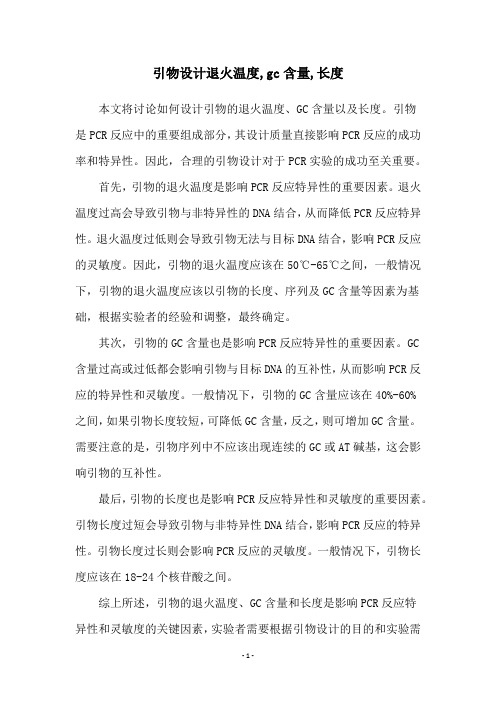
引物设计退火温度,gc含量,长度
本文将讨论如何设计引物的退火温度、GC含量以及长度。
引物
是PCR反应中的重要组成部分,其设计质量直接影响PCR反应的成功率和特异性。
因此,合理的引物设计对于PCR实验的成功至关重要。
首先,引物的退火温度是影响PCR反应特异性的重要因素。
退火温度过高会导致引物与非特异性的DNA结合,从而降低PCR反应特异性。
退火温度过低则会导致引物无法与目标DNA结合,影响PCR反应的灵敏度。
因此,引物的退火温度应该在50℃-65℃之间,一般情况下,引物的退火温度应该以引物的长度、序列及GC含量等因素为基础,根据实验者的经验和调整,最终确定。
其次,引物的GC含量也是影响PCR反应特异性的重要因素。
GC
含量过高或过低都会影响引物与目标DNA的互补性,从而影响PCR反应的特异性和灵敏度。
一般情况下,引物的GC含量应该在40%-60%
之间,如果引物长度较短,可降低GC含量,反之,则可增加GC含量。
需要注意的是,引物序列中不应该出现连续的GC或AT碱基,这会影响引物的互补性。
最后,引物的长度也是影响PCR反应特异性和灵敏度的重要因素。
引物长度过短会导致引物与非特异性DNA结合,影响PCR反应的特异性。
引物长度过长则会影响PCR反应的灵敏度。
一般情况下,引物长度应该在18-24个核苷酸之间。
综上所述,引物的退火温度、GC含量和长度是影响PCR反应特
异性和灵敏度的关键因素,实验者需要根据引物设计的目的和实验需
求,合理设计引物的这三个参数。
引物设计的要求
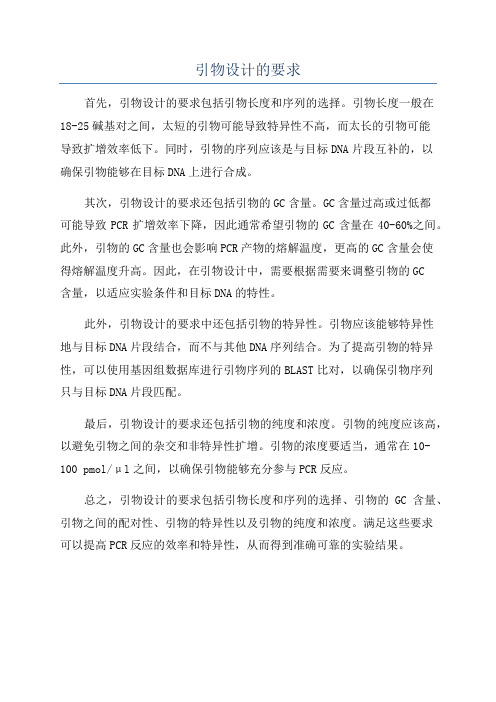
引物设计的要求
首先,引物设计的要求包括引物长度和序列的选择。
引物长度一般在18-25碱基对之间,太短的引物可能导致特异性不高,而太长的引物可能
导致扩增效率低下。
同时,引物的序列应该是与目标DNA片段互补的,以
确保引物能够在目标DNA上进行合成。
其次,引物设计的要求还包括引物的GC含量。
GC含量过高或过低都
可能导致PCR扩增效率下降,因此通常希望引物的GC含量在40-60%之间。
此外,引物的GC含量也会影响PCR产物的熔解温度,更高的GC含量会使
得熔解温度升高。
因此,在引物设计中,需要根据需要来调整引物的GC
含量,以适应实验条件和目标DNA的特性。
此外,引物设计的要求中还包括引物的特异性。
引物应该能够特异性
地与目标DNA片段结合,而不与其他DNA序列结合。
为了提高引物的特异性,可以使用基因组数据库进行引物序列的BLAST比对,以确保引物序列
只与目标DNA片段匹配。
最后,引物设计的要求还包括引物的纯度和浓度。
引物的纯度应该高,以避免引物之间的杂交和非特异性扩增。
引物的浓度要适当,通常在10-100 pmol/μl之间,以确保引物能够充分参与PCR反应。
总之,引物设计的要求包括引物长度和序列的选择、引物的GC含量、引物之间的配对性、引物的特异性以及引物的纯度和浓度。
满足这些要求
可以提高PCR反应的效率和特异性,从而得到准确可靠的实验结果。
引物设计知识点总结大全

引物设计知识点总结大全引物设计是分子生物学和遗传学研究中的重要环节,它在PCR扩增、基因测序、基因突变检测等实验中起着至关重要的作用。
引物设计的好坏会直接影响实验结果的准确性和可靠性。
下面是引物设计的相关知识点总结:一、引物设计的基本原则1. 引物长度:引物长度通常在18-30个碱基对之间,过短的引物容易产生非特异性扩增,过长的引物则会降低扩增效率。
2. 碱基组成:引物的碱基组成应尽量避免多聚腺嘌呤或多聚胸腺嘧啶的情况,以免引起扩增效率降低或引物间的二聚体形成。
3. Tm值匹配:引物的熔解温度(Tm值)应尽量匹配,以确保二聚体形成和特异性扩增。
4. 特异性:引物的特异性是引物设计的关键,必须确保引物只会与待扩增的目标DNA序列特异结合,而不与其他非目标DNA序列结合。
5. 避免互补二聚体:引物之间的互补二聚体会导致扩增效率降低或产生非特异性扩增,因此需要避免引物之间的互补结构。
二、引物设计的工具和方法1. 序列分析工具:常用的序列分析工具包括NCBI的BLAST、Primer-BLAST、OligoAnalyzer等,通过这些工具可以评估引物的特异性和二聚体形成潜力。
2. 引物设计软件:引物设计软件可以根据目标序列自动生成合适的引物序列,在设计引物过程中考虑多个因素如Tm值、长度、特异性等。
常用的软件有Primer3、Primer Premier等。
3. 引物设计策略:根据实验需求选择合适的引物设计策略,常用的策略包括温度梯度扩增引物设计、Asymmetrical PCR引物设计、引物修饰等。
三、引物设计中的注意事项1. 引物位置选择:引物应该选择在目标序列中的稳定区域,避免选择在重复序列、变异位点和剪切酶位点等容易引起问题的区域。
2. 引物长度控制:引物长度的选择需要平衡扩增效率和特异性,过短的引物可能导致扩增效率降低,过长的引物则可能增加非特异性扩增的风险。
3. 引物设计的平衡性:在设计引物时,需要平衡Tm值的匹配、特异性和二聚体形成的可能性,以达到最佳的扩增效果。
PCR的退火温度选择

熔解温度(Tm)是引物的一个重要参数。
这是当50%的引物和互补序列表现为双链DNA分子时的温度・Tm对于设定PCR退火温度是必需的。
在理想状态下,退火温度足够低,以保证引物同目的序列有效退火,同时还要足够高,以减少非待异性结合。
合理的退火温度从55* 到7(TC。
退火温度一般设定比引物的Tm低5它。
设定Tm有几种公式。
有的是来源于高盐溶液中的杂交,适用于小于18碱基的引物。
有的是根据GC 含量估算Tm。
确定引物Tm最可信的方法是近邻分析法。
这种方法从序列一级结构和相邻碱基的特性预测引物的杂交稳定性。
大部分计算机程序使用近邻分析法。
根据所使用的公式及引物序列的不同,Tm会差异很大。
因为大部分公式提供一个估算的Tm 值,所有退火温度只是一个起始点。
可以通过分析几个逐步提高退火温度的反应以提高特异性。
开始低于估算的Tm5°C,以为增量,逐步提高退火温度。
较高的退火温度会减少引物二聚体和非特异性产物的形成。
为获得最佳结果,两个引物应具有近似的Tm值。
引物对的Tm差异如果超过5。
(2,就会引物在循环中使用较低的退火温度而表现出明显的错误起始。
如果两个引物Tm不同,将退火温度设定为比最低的Tm低5它或者为了提高特异性,可以在根据较高Tm设计的退火温度先进行5个循环,然后在根据较低Tm设计的退火温度进行剩余的循环。
这使得在较为严紧的条件下可以荻得目的模板的部分拷贝。
当引物长度低于20个bp可以根据Tm=3GC+2AT,对于更长的寡聚核昔酸,Tm计算公式为:Tm = 81.5+ 16. 6 x LoglO[Na+] + 0.41 (%GC) - 600/size公式中,Size =引物长度。
退火温度取决于引物长度及序列,GC含量越高退火温度越高,引物的Tm值减去5-8度即是引物的退火温度,引物的Tm值一般都会在引物合成单上体现,如果没有的话可以在网上搜个引物退火温度计算器输入序列就可以了。
退火时间一般都是30秒。
引物相关知识点总结大全

引物相关知识点总结大全一、引物的概念引物是指用于核酸杂交、PCR、定量PCR、DNA测序以及RNA分子的反向转录(RT)等实验技术中的一种短链DNA或RNA,通常是15-30个核苷酸的长度。
引物的主要作用是与目标序列中的互补序列形成双链结构,从而引发特定的生物学反应。
在实验室中,引物通常由合成核酸技术制备而成。
二、引物的分类根据引物作用的目标序列不同,引物可分为DNA引物和RNA引物两种。
DNA引物主要用于PCR、序列特异性分析等实验中,而RNA引物则主要用于RT-PCR等实验技术中。
根据引物的长度和作用位置不同,引物可以分为引导引物和扩增引物。
引导引物通常用于核酸杂交、PCR等实验中,用于可选择的结合目标序列,一般长度为15-30个碱基。
扩增引物则主要用于PCR实验中,其长度和序列将直接影响到PCR扩增的结果。
三、引物的设计原则1. 引物的互补性:DNA引物或RNA引物与待扩增的目标序列的互补性是引物设计的基本原则,引物与目标序列要求完全互补,并且在同一温度下具有相似的Tm值。
2. 避免引物二聚体和含量:引物的设计应避免引物自身的二聚体和寡聚体的产生,并且要避免引物的富含量,以提高PCR扩增的效率和特异性。
3. 引物的特异性:引物的设计要求尽量确保引物特异性,即引物只与目标序列特异性结合,不与其他非靶标序列结合。
4. 引物长度和GC含量:引物的长度和GC含量对PCR扩增的特异性和效率有一定的影响,一般长度在18-25个碱基,GC含量在40-60%之间。
5. 引物的5’端末修饰:引物的5’端末修饰,如磷酸化和生物素化等,可以增强引物与酶和材料的连接性和稳定性。
四、引物的应用引物作为实验室技术中的重要工具,在许多生物学实验中都扮演着重要的角色。
其主要应用包括:1. PCR扩增:PCR扩增是引物最常见的应用之一,引物特异性与目标序列的互补性可以实现PCR扩增特定基因或序列。
2. DNA测序:引物也常用于DNA测序技术中,引物和DNA降解酶一起作用可以在酶刻蚀DNA链的末端,并且通过引物的特异性与酶反应的DNA片段在随后的扩增和测序中得到全面和特异性的测序结果。
lncrna引物设计

LncRNA引物设计引言长非编码RNA(long non-coding RNA, lncRNA)是一类RNA分子,其长度通常超过200个核苷酸,在转录后不经过翻译成蛋白质。
然而,lncRNA在基因转录、转座子调控、染色质重塑等多个生物学过程中起着重要作用。
因此,准确地检测和研究lncRNA的表达水平对于揭示其功能机制具有重要意义。
引物设计原理引物设计是检测lncRNA表达水平的关键步骤之一,合理的引物设计能够提高实验的准确性和灵敏性。
在进行lncRNA引物设计时,需要考虑以下几个因素: 1. 引物长度:通常,lncRNA引物的长度应在18-30个碱基对之间,一般选择长度为20个碱基对的引物。
2. 引物Tm值:引物的熔解温度(Tm值)需要在合适范围内,一般选择55-65°C之间的引物,可使用在线工具进行计算。
3. 引物特异性:引物应具有特异性,即能够特异性地与目标lncRNA序列相结合,而不与其他非目标RNA序列结合。
引物设计步骤以下是lncRNA引物设计的一般步骤:1. 获得目标lncRNA序列首先,需要获得目标lncRNA的序列。
可以通过公共数据库(如NCBI、ENSEMBL等)获取序列,或者从已有测序数据中提取目标lncRNA的序列。
2. 确定引物设计区域根据研究需要,确定引物设计区域。
通常选择lncRNA的保守区域或已知功能区域作为引物设计的靶标区域。
3. 利用在线工具进行引物设计使用一些在线工具(例如Primer3、NCBI Primer-BLAST等)进行引物设计。
根据目标lncRNA序列和特定设计要求,输入相关参数进行设计,如引物长度、目标Tm值范围和特异性。
4. 引物评估和筛选根据设计结果,评估引物的特异性和潜在问题。
一般来说,应检查引物是否与其他非目标RNA序列匹配,并使用BLAST等工具进行验证。
排除存在问题的引物,并从设计的引物中选择最佳的候选引物。
5. 引物合成最后,选择最佳的候选引物,并选择合适的商业供应商进行引物合成。
Tm值

Tm值就是DNA熔解温度,指把DNA的双螺旋结构降解一半时的温度。
不同序列的DNA,Tm值不同。
DNA中G-C含量越高,Tm值越高,成正比关系。
Tm是PCR引物设计中
一个非常重要的参数.是指引物与模板之间精确互补并且在模板过量的情况下有50%的引物与模板配对,而另外50%的引物处于解离状态时的温度,Tm值一般高于55度,,设计引物时要注意使两个引物的Tm值相近,否则两个引物不能同时达到退火温度,将影响PCR的扩增结
果!!
计算方法
核酸Tm值(解链温度)计算
评价标准是核酸所吸收的光线量达到其所增加吸收260nm光线的量的两倍达到的温度,当核酸达到Tm值时,其260nm吸收量可增加百分之四十(紫外吸收量随解体程度而增加,直至完全解体。
(1)长度为25mer以下的引物,Tm计算公式为:Tm = 4℃(G + C)+ 2℃(A + T)
(2)对于更长的寡聚核苷酸,Tm计算公式为:
Tm = 81.5 + 16.6 x Log10[Na+] + 0.41 (%GC) – 600/size
公式中,Size = 引物长度
影响Tm值的因素:
①DNA碱基组成:C-G含量越多,Tm值越高;A-T含量越多,Tm值越低。
②溶液的离子强度:在低离子强度中,Tm较低,而且解链的温度范围较宽;在高离子强度中,Tm值较高,解链的温度范围较窄。
③PH值:溶液的PH值在5~9范围内,Tm值变化不明显,当PH>11或PH<4时,Tm值变化明显。
④变性剂:各种变性剂主要是干扰碱基堆积力和氢键的形成而降低Tm值。
⑤DNA双链本身的长度。
PCR引物设计的基本原则

PCR引物设计的基本原则1. 引物的长度一般取15-30bp,常用18-27bp,但不能大于38bp,因为引物过长会导致其延伸温度大于74℃。
2. 引物3’端的序列要比5’端重要。
引物3’端的碱基一般不用A(3’端碱基序列最好是G、C、CG、GC),因为A在错误引发位点的引发效率相对比较高。
另引物间3’端的互补、二聚体或发夹结构也很可能导致PCR反应失败。
5’端序列对PCR 影响不太大,因此常用来引进修饰位点或标记物。
3. 引物的GC含量一般为40-60%,以45-55%为宜,过高或过低都不利于引发反应。
有一些模板本身的GC 含量偏低或偏高,导致引物的GC含量不能在上述范围内,这时应尽量使上下游引物的GC 含量以及Tm 值保持接近(上下游引物的GC含量不能相差太大),以有利于退火温度的选择。
如果G-C比例超出,则在引物的5’端增加As或Ts;而如果A-T比例过高,则同样在5’端增加Gs或Cs。
4. 引物所对应模板序列的Tm 值最好处于72℃左右。
(Tm 值曲线以选取72 度附近为佳,5’到3’的下降形状也有利于引物引发聚合反应),至少要在55-80℃之间5. ΔG值(自由能)反映了引物与模板结合的强弱程度。
一般情况下,引物的ΔG值最好呈正弦曲线,即5’端和中间ΔG值较高,而3’端ΔG值相对较低,且不要超过9(ΔG值为负值,这里取绝对值),如此可防止错误引发。
3′末端双链的ΔG是0~-2 kcal/mol时,PCR产量几乎到百分之百,随着其绝对值的增加产量逐渐下降,在-6时只有40%、到-8时少于20%、而-10时接近于0。
6.错配率一般不要超过100,否则会出现非目的条带。
但是对于某些特定的模板序列,还应结合比较其在正确位点引发效率。
如果两者相差很大,比如在正确位点的引发效率为340以上,而在错误位点的引发效率为110,并且不好找到其他更合适的引物,那么这对引物是可以接受的;7. Frq 曲线为Oligo6新引进的一个指标,揭示了序列片断存在的重复机率大小。
引物设计的重要参数
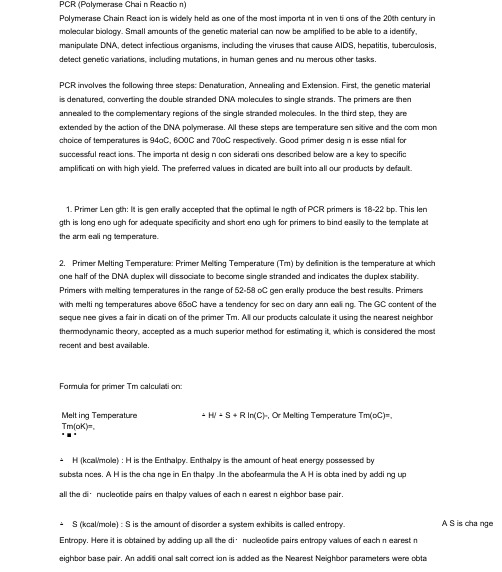
PCR (Polymerase Chai n Reactio n)Polymerase Chain React ion is widely held as one of the most importa nt in ven ti ons of the 20th century inmolecular biology. Small amounts of the genetic material can now be amplified to be able to a identify,manipulate DNA, detect infectious organisms, including the viruses that cause AIDS, hepatitis, tuberculosis,detect genetic variations, including mutations, in human genes and nu merous other tasks.PCR involves the following three steps: Denaturation, Annealing and Extension. First, the genetic materialis denatured, converting the double stranded DNA molecules to single strands. The primers are thenannealed to the complementary regions of the single stranded molecules. In the third step, they areextended by the action of the DNA polymerase. All these steps are temperature sen sitive and the com monchoice of temperatures is 94oC, 6O0C and 70oC respectively. Good primer desig n is esse ntial forsuccessful react ions. The importa nt desig n con siderati ons described below are a key to specificamplificati on with high yield. The preferred values in dicated are built into all our products by default.1. Primer Len gth: It is gen erally accepted that the optimal le ngth of PCR primers is 18-22 bp. This length is long eno ugh for adequate specificity and short eno ugh for primers to bind easily to the template atthe arm eali ng temperature.2. Primer Melting Temperature: Primer Melting Temperature (Tm) by definition is the temperature at whichone half of the DNA duplex will dissociate to become single stranded and indicates the duplex stability.Primers with melting temperatures in the range of 52-58 oC gen erally produce the best results. Primerswith melti ng temperatures above 65oC have a tendency for sec on dary ann eali ng. The GC content of theseque nee gives a fair in dicati on of the primer Tm. All our products calculate it using the nearest neighbor thermodynamic theory, accepted as a much superior method for estimating it, which is considered the mostrecent and best available.Formula for primer Tm calculati on:Melt ing Temperature △ H/ △ S + R ln(C)-, Or Melting Temperature Tm(oC)=,Tm(oK)=,• ■ •△H (kcal/mole) : H is the Enthalpy. Enthalpy is the amount of heat energy possessed bysubsta nces. A H is the cha nge in En thalpy .In the abofearmula the A H is obta ined by addi ng upall the di・nucleotide pairs en thalpy values of each n earest n eighbor base pair.A S is cha nge △S (kcal/mole) : S is the amount of disorder a system exhibits is called entropy.Entropy. Here it is obtained by adding up all the di・nucleotide pairs entropy values of each n earest neighbor base pair. An additi onal salt correct ion is added as the Nearest Neighbor parameters were obtained from DNA melt ing studies con ducted in 1M Na+ buffer and this is the default con diti on used for all calculati ons.WhereN is the number of nucleotide pairs in the primer ( primer length -1). [Na+] is salt equivale nt in mM.[Na+] calculati on: [Na+] = Mono vale nt ion concen trati on +4 x free Mg2+.3. Primer armealing temperature: The primer melting temperature is the estimate of the DNA-DNA hybrid stability and critical in determining the annealing temperature. Too high Ta will produce in sufficie nt primer-template hybridizati on result ing in low PCR product yield. Too low Ta may possibly lead to non-specific products caused by a high nu mber of base pair mismatches,. Mismatch tolera nee is found to have the stro ngest i nflue nee on PCR specificity.Ta = 0.3 x Tm(primer) + 0.7 Tm (product) -14.9where,Tm(primer) = Melt ing Temperature of the primersTm(product) = Melt ing temperature of the product4. GC Con tent: The GC conten t (the nu mber of G f s and C f s in the primer as a perce ntage of the total bases) of primer should be 40-60%.5. GC Clamp: The presenee of G or C bases within the last five bases from the 31 end of primers (GC clamp) helps promote specific binding at the 31 end due to the stron ger bonding of G and C bases. More tha n 3 Gs or C f s should be avoided in the last 5 bases at the 3* end of the primer.6. Primer Secon dary Structures: Prese nee of the primer sec on dary structures produced by in termolecular or in tramolecular in teract ions can lead to poor or no yield of the product. They adversely affect primer template ann eali ng and thus the amplificati on. They greatly reduce the availability of primers to the react ion.i) Hairp ins : It is formed by in tramolecular in teracti on with in the primer and should be avoided. Optimally a 3' end hairpin with a △ Gof -2 kcal/mol and an internal hairpin with a △ Gof ・3 kcal/mol is tolerated gen erally.△ G definition : The Gibbs Free Energy G is the measure of the amount of work that can be extracted from a process operat ing at a con sta nt pressure. It is the measure of the spontan eity of the reaction. The stability of hairpin is commonly represented by its △ Gvalue, the energy required to break the sec on dary structure. Larger n egative value for △ Gin dicates stable, un desirable hairp ins. Prese nee of hairp ins atthe 3* end most adversely affects the react ion. AG = AH TASii) Self Dimer: A primer self-dimer is formed by in termolecular in teract ions betwee n the two (same sen se) primers, where the primer is homologous to itself. Gen erally a large amount of primers are used in PCR compared to the amount of target gene. When primers form intermolecular dimers much more readily than hybridizing to target DNA, they reduce the product yield. Optimally a 3' end self dimer with a -5 kcal/molAGI f internal self dimerwith a GAof -6 kcal/mol is tolerated gen erally.iii) Cross Dimer: Primer cross dimers are formed by intermolecular interaction between sense and an tise nse primers, where they are homologous. Optimally a 3’ end cross dimer with a△-5 kcal/mol and an internal cross dimer with a -6 kcal/mGI of tolerated gen erally.7. Repeats: A repeat is a di・nucleotide occurring many times consecutively and should be avoided because they can misprime. For example: ATAT AT AT. A maximum nu mber of di-nu cleotide repeats acceptable in an oligo is 4 di・nu cleotides.8. Runs: Primers with long runs of a sin gle base should gen erally be avoided as they can misprime. For example, AGCGGGGGATGGGG has runs of base 'G of value 5 and 4. A maximum number of runs accepted is 4bp.9. 3’ End Stability : It is the maximum △ G value of the five bases from the 3f end. An unstable3*end (less n egative △ G) will result in less false prim ing.10. Avoid Template sec on dary structure: A sin gle stra nded Nucleic acid seque nces is highly unstable and fold into conformations (secondary structures). The stability of these template sec on dary structures depe nds largely on their free en ergy and melt ing temperatures(Tm). Con siderati on of template sec on dary structures is importa nt in desig ning primers, especially in qPCR. If primers are desig ned on a sec on dary structures which is stable even above the ann eali ng temperatures, the primers are unable to bind to the template and the yield of PCR product is significantly affected. Hence5 it is important to design primers in the regions of the templates thatdo not form stable sec on dary structures duri ng the PCR reacti on. Our products determ ine the sec on dary structures of the template and desig n primers avoid ing them.11 • Avoid Cross homology: To improve specificity of the primers it is necessary to avoid regions of homology. Primers designed for a sequenee must not amplify other genes in the mixture. Commonly, primers are desig ned and the n BLASTed to test the specificity. Our products offer a better alter native.You can avoid regions of cross homology while designing primers. You can BLAST the templates against the appropriate non-redundant database and the software will interpret the results. It will identify regions significant cross homologies in each template and avoid them during primer search.Parameters for Primer Pair Desig n1. Amplicon Length: The amplicon length is dictated by the experimental goals. For qPCR,the target len gth is closer to 100 bp and for standard. PCR, . it is n ear 500 bp. If you know the positi onsof each primer with respect to the template, the product is calculated as: Product length = (Position of antisense primer-Position of sense primer) + 1.2. Product positi on: Primer can be located n ear the 5f end, the 3' end or any where with in specified len gth. Gen erally, the seque nee close to the 3* end is known with greater con fide neeand hence preferred most freque ntly.3. Tm of Product: Melting Temperature (Tm) is the temperature at which one half of the DNA duplex will dissociate and become single strandecL The stability of the primer-template DNA duplex can be measured by the melt ing temperature (Tm).4. Optimum Annealing temperature (Ta Opt): The formula of Rychlik is most respected. Our products use this formula to calculate it and thousands of our customers have reported good results using it for the ann eali ng step of the PCR cycle. It usually results in good PCR product yield with minimum false product product! on.Ta Opt = 0.3 x(Tm of primer) + 0.7 x(Tm of product) -14.9whereTm of primer is the melting temperature of the less stable primer-template pairTm of product is the melt ing temperature of the PCR product.5. Primer Pair Tm Mismatch Calculation: The two primers of a primer pair should have closely matched melt ing temperatures for maximizi ng PCR product yield. The differe nee of 5oC or more can lead no amplification.。
QPCR引物设计要点

QPCR引物设计要点一、设计对象及分析目的1.分析对象则为设计对象;但具体的实验对象因具体的实验方法而异;2.表达水平分析(定量):RNA(mRNA, lncRNA, rRNA, tRNA, miRNA, piRNA);3.存在分析(定性):DNA (CHIP-QPCR), RNA (RIP-QPCR);4.等位基因拷贝数分析:DNA (LOH);5.甲基化分析:重亚硫酸盐转化后的基因组DNA序列(可以假设CpG位点的C全部发生甲基化,或CpG位点的C全部未发生甲基化);6.设计模板:序列号或具体的序列(见图1)二、设计参数以在线软件为例:/tools/primer-blast/ 1.PCR产物的长度(PCR product size):一般为80-200bp,最好为:90-140 bp(图2);2.引物的退火温度(Primer melting temperatures, TM):59-60℃,最优为60℃(在实际进行QPCR反应时,TM值为60℃)(图2);3.跨外显子(span an exon-exon junction):其中一条引物落在相邻两个外显子的交界上,其作用是避免所提取的总RNA污染了基因DNA所造成的假阳性(图3),如果设计模板为基因组DNA(重亚硫酸盐处理的DNA序列)则不需遵守;4.跨内含子(separated by at least one intron):正反引物分别落在相邻的两个外显子上,其作用是避免所提取的总RNA污染了基因DNA所造成的假阳性(图3),如果设计模板为基因组DNA(重亚硫酸盐处理的DNA序列)则不需遵守;5.BLAST检索引物的特异性,根据设计对象的属性选择合适的数据库种类(图4),输入检测样本的种属(图5);6.引物的要求:长度为18-26bp,最优为23bp, 引物的GC含量为50-60%,引物中连续出现的相同碱基的数目不超过4(图6);7.计算引物TM值的参数:QPCR反应体系中的一价盐离子,二价盐离子,dNTP的浓度和引物的浓度均可影响TM值(图7);8.引物尽量不含已知的SNP位点(图8),否则存在出现碱基错配的风险;。
测序引物设计指南
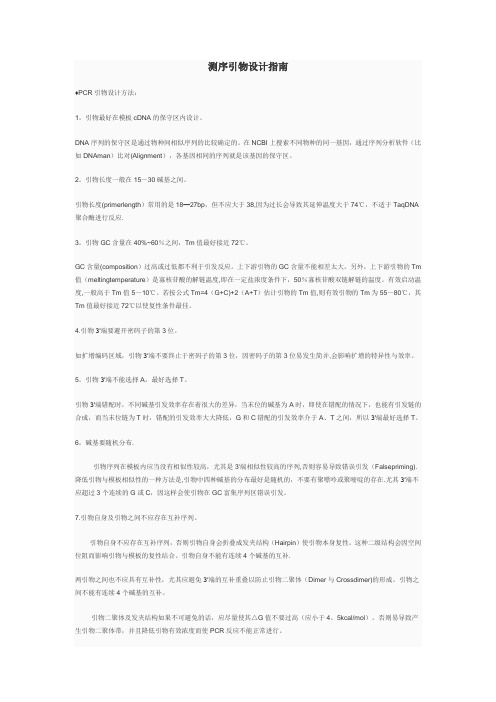
测序引物设计指南♦PCR引物设计方法:1。
引物最好在模板cDNA的保守区内设计。
DNA序列的保守区是通过物种间相似序列的比较确定的。
在NCBI上搜索不同物种的同一基因,通过序列分析软件(比如DNAman)比对(Alignment),各基因相同的序列就是该基因的保守区。
2。
引物长度一般在15~30碱基之间。
引物长度(primerlength)常用的是18—27bp,但不应大于38,因为过长会导致其延伸温度大于74℃,不适于TaqDNA 聚合酶进行反应.3。
引物GC含量在40%~60%之间,Tm值最好接近72℃。
GC含量(composition)过高或过低都不利于引发反应。
上下游引物的GC含量不能相差太大。
另外,上下游引物的Tm 值(meltingtemperature)是寡核苷酸的解链温度,即在一定盐浓度条件下,50%寡核苷酸双链解链的温度。
有效启动温度,一般高于Tm值5~10℃。
若按公式Tm=4(G+C)+2(A+T)估计引物的Tm值,则有效引物的Tm为55~80℃,其Tm值最好接近72℃以使复性条件最佳。
4.引物3′端要避开密码子的第3位。
如扩增编码区域,引物3′端不要终止于密码子的第3位,因密码子的第3位易发生简并,会影响扩增的特异性与效率。
5。
引物3′端不能选择A,最好选择T。
引物3′端错配时,不同碱基引发效率存在着很大的差异,当末位的碱基为A时,即使在错配的情况下,也能有引发链的合成,而当末位链为T时,错配的引发效率大大降低,G和C错配的引发效率介于A、T之间,所以3′端最好选择T。
6。
碱基要随机分布.引物序列在模板内应当没有相似性较高,尤其是3'端相似性较高的序列,否则容易导致错误引发(Falsepriming).降低引物与模板相似性的一种方法是,引物中四种碱基的分布最好是随机的,不要有聚嘌呤或聚嘧啶的存在.尤其3′端不应超过3个连续的G或C,因这样会使引物在GC富集序列区错误引发。
设计pcr引物的注意事项

设计pcr引物的注意事项
设计PCR引物的注意事项包括以下几点:
1.引物长度:一般为15~30个碱基,引物太短会降低扩增特异性。
引物过长退火温度会提高,不利于反应的发生。
2.引物序列:设计引物时碱基要随机分布,避免碱基或核苷酸的重
复导致错误引发;引物间和引物自身序列也要尽量避免互补,防止形成引物二聚体或发夹结构。
3.碱基分布:GC含量一般40-60%,含量过高或过低都不利于进行
反应。
其含量过低会使引物不稳定;过高会引发非特异性扩增。
4.Tm值:引物的Tm值(解链温度)=4(G+C)+2(A+T),尽可能
保证上下游引物的Tm值一致,一般不超过2℃。
5.引物设计好后进行BLAST检查,检测是否与基因组中重复序列或
其它基因位点有交叉同源。
6.引物的特异性:引物的3'端如果含有一个G或C残基能增加引物
的特异性。
请注意,以上仅为PCR引物设计的基本原则,具体操作时可能还需要考虑其他因素,建议咨询专业人士获取帮助。
引物设计的原理和程序

引物设计的原理和程序引物设计是在分子生物学领域中非常重要的一项技术,用于在DNA或RNA序列中选择特定的区域进行放大、克隆或检测。
引物设计的目标是选择具有高度特异性和高效性的引物,以确保所需的目标序列可以准确地被扩增或检测到。
以下是引物设计的原理和程序的详细说明。
1.特异性:引物应该在目标区域具有高度特异性,即只与目标序列配对,并排除与非目标序列的配对。
这可以通过确保引物序列在目标区域的起始位置和长度与目标序列相匹配来实现。
2.合成效率:引物应该具有高合成效率,以确保引物在PCR或其他实验过程中可以被充分放大或扩增。
合成效率可以通过一些计算方法如GC 含量、引物长度和翻转重复等特征进行评估。
3.避免互补配对:引物设计时应避免两个引物之间或引物与DNA模板之间形成互补配对。
互补配对可能会导致引物之间的二聚体形成或降低引物与目标区域的结合能力。
引物设计通常分为两个主要步骤:目标序列选择和引物设计。
1.目标序列选择:选择目标序列是引物设计的第一步。
目标序列通常是想要扩增或检测的DNA或RNA片段。
这可以是已知序列的基因、intergenic区域、病毒或细菌的片段等。
目标序列的选择需要考虑研究的目的以及实验的具体要求。
2.引物设计:引物设计是根据目标序列选择适当的引物。
引物设计可以通过多种计算机程序或在线工具来实现。
a.引物长度选择:引物长度通常在18到30个碱基对之间,具体长度的选择取决于目标序列的特点和实验需求。
较长的引物可以提供更好的特异性,但可能会降低扩增效率。
b.GC含量计算:GC含量是引物设计中的一个重要参数,通常在40%到60%之间。
GC含量高的引物可以提供更好的热稳定性和特异性,但过高或过低的GC含量都可能影响引物的性能。
c.特异性评估:引物的特异性可以通过与非目标序列进行比对来评估。
在引物设计过程中,首先应排除与非目标序列存在高度相似度的区域,然后检查目标序列中引物能否与其他非目标序列配对。
PCR的退火温度选择
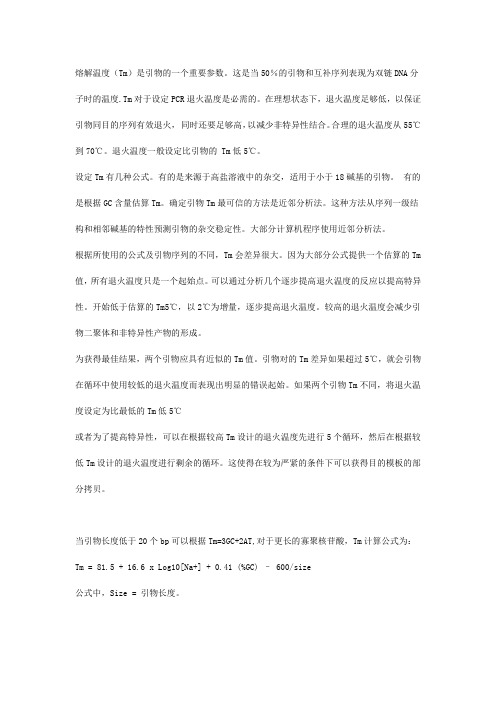
熔解温度(Tm)是引物的一个重要参数。
这是当50%的引物和互补序列表现为双链DNA分子时的温度.Tm对于设定PCR退火温度是必需的。
在理想状态下,退火温度足够低,以保证引物同目的序列有效退火,同时还要足够高,以减少非特异性结合。
合理的退火温度从55℃到70℃。
退火温度一般设定比引物的 Tm低5℃。
设定Tm有几种公式。
有的是来源于高盐溶液中的杂交,适用于小于18碱基的引物。
有的是根据GC含量估算Tm。
确定引物Tm最可信的方法是近邻分析法。
这种方法从序列一级结构和相邻碱基的特性预测引物的杂交稳定性。
大部分计算机程序使用近邻分析法。
根据所使用的公式及引物序列的不同,Tm会差异很大。
因为大部分公式提供一个估算的Tm 值,所有退火温度只是一个起始点。
可以通过分析几个逐步提高退火温度的反应以提高特异性。
开始低于估算的Tm5℃,以2℃为增量,逐步提高退火温度。
较高的退火温度会减少引物二聚体和非特异性产物的形成。
为获得最佳结果,两个引物应具有近似的Tm值。
引物对的Tm差异如果超过5℃,就会引物在循环中使用较低的退火温度而表现出明显的错误起始。
如果两个引物Tm不同,将退火温度设定为比最低的Tm低5℃或者为了提高特异性,可以在根据较高Tm设计的退火温度先进行5个循环,然后在根据较低Tm设计的退火温度进行剩余的循环。
这使得在较为严紧的条件下可以获得目的模板的部分拷贝。
当引物长度低于20个bp可以根据Tm=3GC+2AT,对于更长的寡聚核苷酸,Tm计算公式为:Tm = 81.5 + 16.6 x Log10[Na+] + 0.41 (%GC) – 600/size公式中,Size = 引物长度。
退火温度取决于引物长度及序列,GC含量越高退火温度越高,引物的Tm值减去5-8度即是引物的退火温度,引物的Tm值一般都会在引物合成单上体现,如果没有的话可以在网上搜个引物退火温度计算器输入序列就可以了。
退火时间一般都是30秒。
试试下载一个Oligo6.0,这个软件挺不错的,在计算出来的退火温度基础上上下幅度一点是没有什么问题的bioxm2.6 更专业软件很小很方便更能还挺强大我们刚做了PCR实验,当引物长度小于25bp时,退火温度通过(Tm-5)℃计算,Tm=4(G+C)+2(A+T)增加PCR的特异性:1. primers design这是最重要的一步。
引物设计的详细步骤

引物设计的详细步骤引物设计步骤如下:1.目标序列选择:根据研究目的选择需要扩增或检测的目标DNA序列。
这个目标序列可能是基因的特定区域、启动子区域、外显子、cDNA序列等。
选择一个合适的目标序列对于引物设计至关重要,因为它将决定引物的特异性和扩增产物的大小。
一般而言,目标序列具有良好的保守性和特异性。
2.引物长度和Tm计算:引物通常是15-30个核苷酸长度。
引物长度的选择取决于目标序列的特点以及所使用的实验条件。
合适的引物长度应该综合考虑引物的特异性和扩增效率。
引物的熔解温度(Tm)是指DNA链的两个链断裂开所需要的温度,它是引物设计中一个重要的参数。
Tm可以通过计算引物的碱基组成、盐度和引物浓度等因素来估计,通常约为55-65℃。
3. 引物特异性检查:使用生物信息学工具,如BLAST(Basic Local Alignment Search Tool)或NCBI(National Center forBiotechnology Information)数据库来检查所设计引物的特异性。
确保引物不会扩增与目标序列不匹配的区域,避免非特异性扩增和假阳性结果。
4.引物序列设计:根据目标序列和引物长度选择合适的引物序列。
引物设计的要求包括:GC含量约为40-60%、避免重复序列和目标序列内部的局部重复、避免碱基偏差和突变等。
此外,引物的碱基组成应该是均匀的,避免多个连续G或C碱基的存在。
6.引物的合成:将设计好的引物交给合成公司进行合成,通常采用化学合成方法。
引物的质量控制非常重要,合成的引物应进行质控检测,如毛细管电泳或质谱分析。
推荐文献:2. Untergasser A, et al. (2024) Primer3--new capabilities and interfaces. Nucleic Acids Res. 40(15): e115.。
引物设计是分子生物学研究中必不可少的技术之一、通过遵循上述步骤和参考推荐文献,可以设计出特异性高、效率好的引物,为后续实验的顺利进行提供支持。
引物设计注意事项
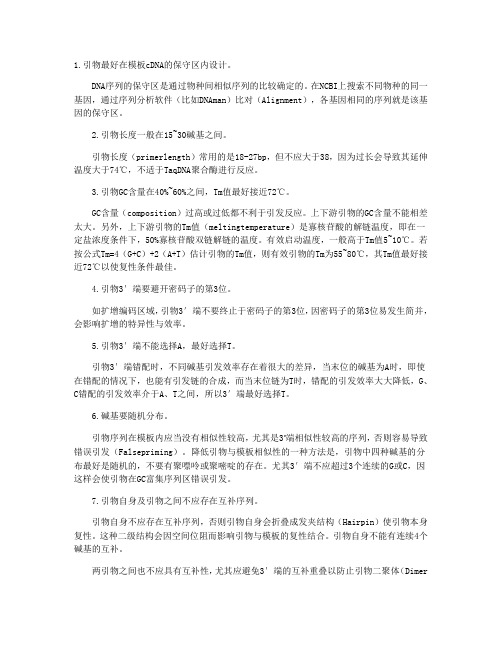
1.引物最好在模板cDNA的保守区内设计。
DNA序列的保守区是通过物种间相似序列的比较确定的。
在NCBI上搜索不同物种的同一基因,通过序列分析软件(比如DNAman)比对(Alignment),各基因相同的序列就是该基因的保守区。
2.引物长度一般在15~30碱基之间。
引物长度(primerlength)常用的是18-27bp,但不应大于38,因为过长会导致其延伸温度大于74℃,不适于TaqDNA聚合酶进行反应。
3.引物GC含量在40%~60%之间,Tm值最好接近72℃。
GC含量(composition)过高或过低都不利于引发反应。
上下游引物的GC含量不能相差太大。
另外,上下游引物的Tm值(meltingtemperature)是寡核苷酸的解链温度,即在一定盐浓度条件下,50%寡核苷酸双链解链的温度。
有效启动温度,一般高于Tm值5~10℃。
若按公式Tm=4(G+C)+2(A+T)估计引物的Tm值,则有效引物的Tm为55~80℃,其Tm值最好接近72℃以使复性条件最佳。
4.引物3′端要避开密码子的第3位。
如扩增编码区域,引物3′端不要终止于密码子的第3位,因密码子的第3位易发生简并,会影响扩增的特异性与效率。
5.引物3′端不能选择A,最好选择T。
引物3′端错配时,不同碱基引发效率存在着很大的差异,当末位的碱基为A时,即使在错配的情况下,也能有引发链的合成,而当末位链为T时,错配的引发效率大大降低,G、C错配的引发效率介于A、T之间,所以3′端最好选择T。
6.碱基要随机分布。
引物序列在模板内应当没有相似性较高,尤其是3’端相似性较高的序列,否则容易导致错误引发(Falsepriming)。
降低引物与模板相似性的一种方法是,引物中四种碱基的分布最好是随机的,不要有聚嘌呤或聚嘧啶的存在。
尤其3′端不应超过3个连续的G或C,因这样会使引物在GC富集序列区错误引发。
7.引物自身及引物之间不应存在互补序列。
引物自身不应存在互补序列,否则引物自身会折叠成发夹结构(Hairpin)使引物本身复性。
引物设计的一些要素
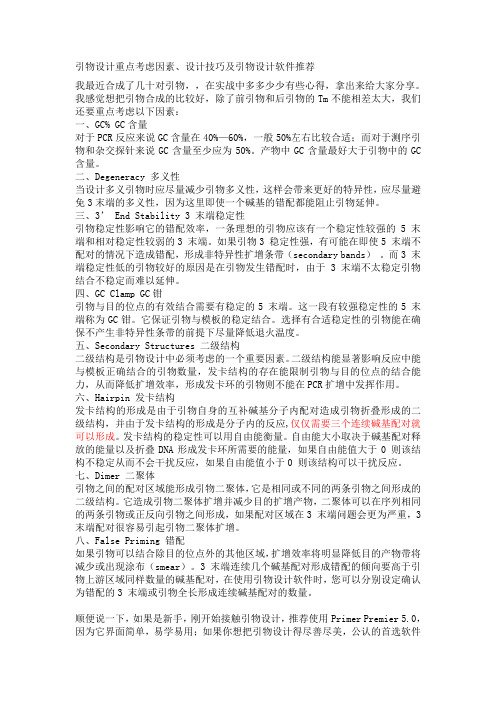
引物设计重点考虑因素、设计技巧及引物设计软件推荐我最近合成了几十对引物,,在实战中多多少少有些心得,拿出来给大家分享。
我感觉想把引物合成的比较好,除了前引物和后引物的Tm不能相差太大,我们还要重点考虑以下因素:一、GC% GC含量对于PCR反应来说GC含量在40%—60%,一般50%左右比较合适;而对于测序引物和杂交探针来说GC含量至少应为50%。
产物中GC含量最好大于引物中的GC 含量。
二、Degeneracy 多义性当设计多义引物时应尽量减少引物多义性,这样会带来更好的特异性,应尽量避免3末端的多义性,因为这里即使一个碱基的错配都能阻止引物延伸。
三、3’ End Stability 3 末端稳定性引物稳定性影响它的错配效率,一条理想的引物应该有一个稳定性较强的 5 末端和相对稳定性较弱的3 末端。
如果引物3 稳定性强,有可能在即使5 末端不配对的情况下造成错配,形成非特异性扩增条带(secondary bands)。
而3 末端稳定性低的引物较好的原因是在引物发生错配时,由于 3 末端不太稳定引物结合不稳定而难以延伸。
四、GC Clamp GC钳引物与目的位点的有效结合需要有稳定的5 末端。
这一段有较强稳定性的5 末端称为GC钳。
它保证引物与模板的稳定结合。
选择有合适稳定性的引物能在确保不产生非特异性条带的前提下尽量降低退火温度。
五、Secondary Structures 二级结构二级结构是引物设计中必须考虑的一个重要因素。
二级结构能显著影响反应中能与模板正确结合的引物数量,发卡结构的存在能限制引物与目的位点的结合能力,从而降低扩增效率,形成发卡环的引物则不能在PCR扩增中发挥作用。
六、Hairpin 发卡结构发卡结构的形成是由于引物自身的互补碱基分子内配对造成引物折叠形成的二级结构,并由于发卡结构的形成是分子内的反应,仅仅需要三个连续碱基配对就可以形成。
发卡结构的稳定性可以用自由能衡量。
自由能大小取决于碱基配对释放的能量以及折叠DNA形成发卡环所需要的能量,如果自由能值大于0 则该结构不稳定从而不会干扰反应,如果自由能值小于0 则该结构可以干扰反应。
引物设计的基本原则及循环参数

反应的控制①PCR反应的缓冲液提供合适的酸碱度与某些离子;②镁离子浓度总量应比dNTPs的浓度高,常用1.5mmol/L;③底物浓度 dNTP以等摩尔浓度配制,20~200umol/L;④TaqDNA聚合酶 2.5U(100ul);⑤引物浓度一般为0.1 ~ 0.5umol/L;⑥反应温度和循环次数变性温度和时间 95℃,30s;退火温度和时间低于引物Tm值5 ℃左右,一般在45~55℃延伸温度和时间 72℃,1min/kb(10kb内)Tm值=4(G+C) +2(A+T)循环参数循环次数一般为25 ~ 30次。
循环数决定PCR扩增的产量。
模板初始浓度低,可增加循环数以便达到有效的扩增量。
但循环数并不是可以无限增加的。
一般循环数为30个左右,循环数超过30个以后,DNA聚合酶活性逐渐达到饱和,产物的量不再随循环数的增加而增加,出现了所谓的“平台期”。
1.预变性:模板DNA完全变性与PCR酶的完全激活对PCR能否成功至关重要,一般未修饰的Taq酶激活时间为两分钟。
2.变性步骤:循环中一般95℃,30秒足以使各种靶DNA序列完全变性,可能的情况下可缩短该步骤时间变性时间过长损害酶活性,过短靶序列变性不彻底,易造成扩增失败。
3.引物退火:退火温度需要从多方面去决定,一般根据引物的Tm值为参考,根据扩增的长度适当下调作为退火温度。
然后在此次实验基础上做出预估。
退火温度对PCR的特异性有较大影响。
4.引物延伸:引物延伸一般在72℃进行(Taq酶最适温度)。
但在扩增长度较短且退火温度较高时,本步骤可省略延伸时间随扩增片段长短而定,一般推荐在1000bp以上,含Pfu及其衍生物的衍生设定为1min/kbp。
大多数PCR含25-35循环,过多易产生非特异扩增。
最后延伸在最后一个循环后,反应在72℃维持10-30分钟.使引物延伸完全,并使单链产物退火成双链。
- 1、下载文档前请自行甄别文档内容的完整性,平台不提供额外的编辑、内容补充、找答案等附加服务。
- 2、"仅部分预览"的文档,不可在线预览部分如存在完整性等问题,可反馈申请退款(可完整预览的文档不适用该条件!)。
- 3、如文档侵犯您的权益,请联系客服反馈,我们会尽快为您处理(人工客服工作时间:9:00-18:30)。
PCR (Polymerase Chain Reaction)Polymerase Chain Reaction is widely held as one of the most important inventions of the 20th century in molecular biology. Small amounts of the genetic material can now be amplified to be able to a identify, manipulate DNA, detect infectious organisms, including the viruses that cause AIDS, hepatitis, tuberculosis, detect genetic variations, including mutations, in human genes and numerous other tasks.PCR involves the following three steps: Denaturation, Annealing and Extension. First, the genetic material is denatured, converting the double stranded DNA molecules to single strands. The primers are then annealed to the complementary regions of the single stranded molecules. In the third step, they are extended by the action of the DNA polymerase. All these steps are temperature sensitive and the common choice of temperatures is 94oC, 60oC and 70oC respectively. Good primer design is essential for successful reactions. The important design considerations described below are a key to specific amplification with high yield. The preferred values indicated are built into all our products by default.1. Primer Length: It is generally accepted that the optimal length of PCR primers is 18-22 bp. This length is long enough for adequate specificity and short enough for primers to bind easily to the template at the annealing temperature.2. Primer Melting Temperature: Primer Melting Temperature (Tm) by definition is the temperature at which one half of the DNA duplex will dissociate to become single stranded and indicates the duplex stability. Primers with melting temperatures in the range of 52-58 oC generally produce the best results. Primers with melting temperatures above 65oC have a tendency for secondary annealing. The GC content of the sequence gives a fair indication of the primer Tm. All our products calculate it using the nearest neighbor thermodynamic theory, accepted as a much superior method for estimating it, which is considered the most recent and best available.Formula for primer Tm calculation:Melting Temperature Tm(oK)=,ΔH/ ΔS + R ln(C)-, Or Melting Temperature Tm(oC) = ,ΔH/ ΔS + R ln(C)} - 273.15 whereΔH (kcal/mole) : H is the Enthalpy. Enthalpy is the amount of heat energy possessed by substances. ΔH is the change in Enthalpy. In the above formula the ΔH is obtained by adding up all the di-nucleotide pairs enthalpy values of each nearest neighbor base pair.ΔS (kcal/mole) : S is the amount of disorder a system exhibits is called entropy. ΔS is change in Entropy. Here it is obtained by adding up all the di-nucleotide pairs entropy values of each nearest neighbor base pair. An additional salt correction is added as the Nearest Neighbor parameters were obtained from DNA melting studies conducted in 1M Na+ buffer and this is thedefault condition used for all calculations.ΔS (salt correction) = ΔS (1M NaCl )+ 0.368 x N x ln(*Na++)WhereN is the number of nucleotide pairs in the primer ( primer length -1).[Na+] is salt equivalent in mM.[Na+] calculation:[Na+] = Monovalent ion concentration +4 x free Mg2+.3. Primer annealing temperature: The primer melting temperature is the estimate of the DNA-DNA hybrid stability and critical in determining the annealing temperature. Too high Ta will produce insufficient primer-template hybridization resulting in low PCR product yield. Too low Ta may possibly lead to non-specific products caused by a high number of base pair mismatches,. Mismatch tolerance is found to have the strongest influence on PCR specificity.Ta = 0.3 x Tm(primer) + 0.7 Tm (product) – 14.9where,Tm(primer) = Melting Temperature of the primersTm(product) = Melting temperature of the product4. GC Content: The GC content (the number of G's and C's in the primer as a percentage of the total bases) of primer should be 40-60%.5. GC Clamp: The presence of G or C bases within the last five bases from the 3' end of primers (GC clamp) helps promote specific binding at the 3' end due to the stronger bonding of G and C bases. More than 3 G's or C's should be avoided in the last 5 bases at the 3' end of the primer.6. Primer Secondary Structures: Presence of the primer secondary structures produced by intermolecular or intramolecular interactions can lead to poor or no yield of the product. They adversely affect primer template annealing and thus the amplification. They greatly reduce the availability of primers to the reaction.i) Hairpins : It is formed by intramolecular interaction within the primer and should be avoided. Optimally a 3' end hairpin with a ΔG of -2 kcal/mol and an internal hairpin with a ΔG of -3 kcal/mol is tolerated generally.ΔG definition : The Gibbs Free Energy G is the measure of the amount of work that can beextracted from a process operating at a constant pressure. It is the measure of the spontaneity of the reaction. The stability of hairpin is commonly represented by its ΔG value, the energy required to break the secondary structure. Larger negative value for ΔG indicates stable, undesirable hairpins. Presence of hairpins at the 3' end most adversely affects the reaction.ΔG = ΔH –TΔSii) Self Dimer : A primer self-dimer is formed by intermolecular interactions between the two (same sense) primers, where the primer is homologous to itself. Generally a large amount of primers are used in PCR compared to the amount of target gene. When primers form intermolecular dimers much more readily than hybridizing to target DNA, they reduce the product yield. Optimally a 3' end self dimer with a ΔG of -5 kcal/mol and an internal self dimer with a ΔG of -6 kcal/mol is tolerated generally.iii) Cross Dimer : Primer cross dimers are formed by intermolecular interaction between sense and antisense primers, where they are homologous. Optimally a 3' end cross dimer with a ΔG of -5 kcal/mol and an internal cross dimer with a ΔG of -6 kcal/mol is tolerated generally.7. Repeats: A repeat is a di-nucleotide occurring many times consecutively and should be avoided because they can misprime. For example: ATATATAT. A maximum number of di-nucleotide repeats acceptable in an oligo is 4 di-nucleotides.8. Runs: Primers with long runs of a single base should generally be avoided as they can misprime. For example, AGCGGGGGATGGGG has runs of base 'G' of value 5 and 4. A maximum number of runs accepted is 4bp.9. 3' End Stability: It is the maximum ΔG value of the five bases from the 3' end. An unstable 3' end (less negative ΔG) will result in less false priming.10. Avoid Template secondary structure: A single stranded Nucleic acid sequences is highly unstable and fold into conformations (secondary structures). The stability of these template secondary structures depends largely on their free energy and melting temperatures(Tm). Consideration of template secondary structures is important in designing primers, especially in qPCR. If primers are designed on a secondary structures which is stable even above the annealing temperatures, the primers are unable to bind to the template and the yield of PCR product is significantly affected. Hence, it is important to design primers in the regions of the templates that do not form stable secondary structures during the PCR reaction. Our products determine the secondary structures of the template and design primers avoiding them.11. Avoid Cross homology: To improve specificity of the primers it is necessary to avoid regions of homology. Primers designed for a sequence must not amplify other genes in the mixture. Commonly, primers are designed and then BLASTed to test the specificity. Our products offer a better alternative. You can avoid regions of cross homology while designing primers. You can BLAST the templates against the appropriate non-redundant database and the software willinterpret the results. It will identify regions significant cross homologies in each template and avoid them during primer search.Parameters for Primer Pair Design1. Amplicon Length: The amplicon length is dictated by the experimental goals. For qPCR, the target length is closer to 100 bp and for standard PCR, it is near 500 bp. If you know the positions of each primer with respect to the template, the product is calculated as: Product length = (Position of antisense primer-Position of sense primer) + 1.2. Product position: Primer can be located near the 5' end, the 3' end or any where within specified length. Generally, the sequence close to the 3' end is known with greater confidence and hence preferred most frequently.3. Tm of Product: Melting Temperature (Tm) is the temperature at which one half of the DNA duplex will dissociate and become single stranded. The stability of the primer-template DNA duplex can be measured by the melting temperature (Tm).4. Optimum Annealing temperature (Ta Opt): The formula of Rychlik is most respected. Our products use this formula to calculate it and thousands of our customers have reported good results using it for the annealing step of the PCR cycle. It usually results in good PCR product yield with minimum false product production.Ta Opt = 0.3 x(Tm of primer) + 0.7 x(Tm of product) - 14.9whereTm of primer is the melting temperature of the less stable primer-template pairTm of product is the melting temperature of the PCR product.5. Primer Pair Tm Mismatch Calculation: The two primers of a primer pair should have closely matched melting temperatures for maximizing PCR product yield. The difference of 5oC or more can lead no amplification.。
